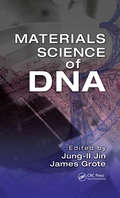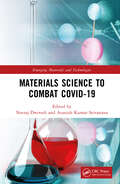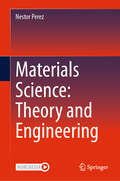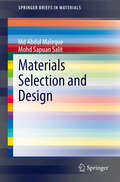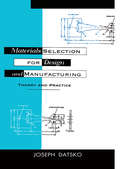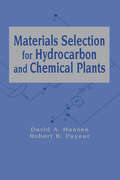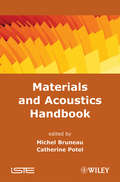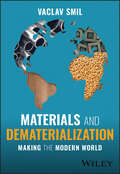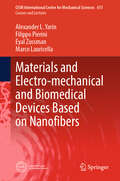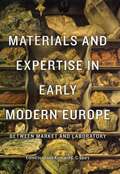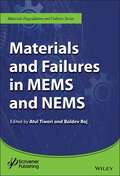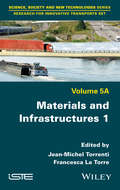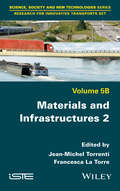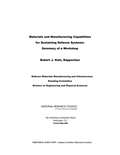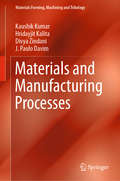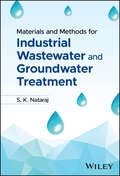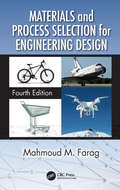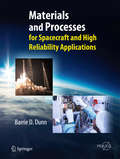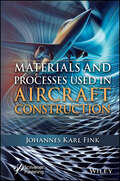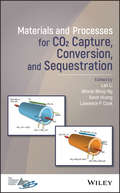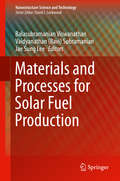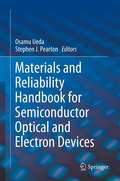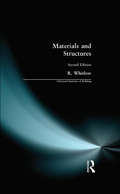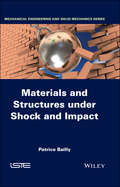- Table View
- List View
Materials Science of DNA
by James Grote Jung-Ii JinThe field of materials science and technology has undergone revolutionary advances due to the development of novel analytical tools, functional materials, and multidisciplinary approaches to engineering. Additionally, theoretical predictions combined with increasingly improved models and computational capabilities are making impressive contribution
Materials Science to Combat COVID-19 (Emerging Materials and Technologies)
by Avanish Kumar Srivastava Neeraj DwivediThis book covers the application of emerging materials to combat coronavirus. It discusses various physicochemical and biomedical characteristics of 2D materials, such as graphene, MXenes, and their various other derivatives, followed by proposal of how such materials can be used to design and develop several systems capable of fighting infectious diseases like coronavirus. It also covers fundamental and product developments based on MXene and graphene-based materials using emerging 3D printing process and other pertinent aspects. Features: • Focusses on COVID-19 from cross-disciplinary approach, especially biophysical management of the virus. • Discusses emerging 2D materials such as MXene and graphene to combat coronavirus. • Reviews development of PPEs, sterilizers, foams, antimicrobial surfaces, biosensors from materials science perspective. • Explores pertinent fundamental mechanisms to develop structure・property relationships. • Examines cytotoxicity and biocompatibility of the discussed 2D materials. This book is aimed at researchers and graduate students in biotechnology, biomedical engineering, chemical engineering, and materials science.
Materials Science: Theory and Engineering
by Nestor PerezThis textbook presents a compilation of class-tested materials and the results of research on a range of topics in into one comprehensive volume for readers engaged in the materials science and engineering aspects of phase transformation in metals. Accordingly, this is a suitable textbook for undergraduate and graduate students in the fields of mechanical engineering, materials science, metallurgical engineering, and related disciplines. The book incorporates two-dimensional materials, crystal defects, mass transport, thermodynamics of phase, solidification heat transfer, solidification and phase diagrams related to nucleation particle phases and explains solid-state phase transformation, mechanical behaviour and fracture toughness, non-destructive methods, physical and optical properties of solids, and electrochemical corrosion. It also stands as an excellent reference treatise for practicing and consulting engineers. Moreover, the book is appropriate for graduate-level coursework, covering advanced subjects including quantum mechanics, two dimensional materials, fracture mechanics, non-destructive methods for evaluating structural integrity, and advanced analytical techniques in some appendices.
Materials Selection and Design
by Md Abdul Maleque Mohd Sapuan SalitThis book presents topics on the basics of materials selection and design which will give a better understanding on the selection methods and then find suitable materials for the applications. This book draws the simple and straightforward quantitative methods followed by knowledge-based expert system approach with real and tangible case studies to show how undergraduate or post-graduate students or engineers can apply their knowledge on materials selection and design. Topics discussed in this book contain special features such as illustration, tables and tutorial questions for easy understanding. A few published books or documents are available, hence this book will be very useful for those who use (or want to use) materials selection approach without the advantages of having had comprehensive knowledge or expertise in this materials' world.
Materials Selection for Design and Manufacturing: Theory and Practice
by Joseph DatskoProviding an analytical approach to selecting the best metal and obtaining optimal properties for and in a fabricated part, this text correlates weldability, formability and machinability with a metal's chemical composition through microstructures. It begins with a review of the principles of materials science and offers useful features, such as end-of-chapter problems and a solutions manual.
Materials Selection for Hydrocarbon and Chemical Plants
by HansenDescribes the systematic procedure for using process and mechanical design information to select construction materials suitable for a range of chemical and hydrocarbon processing plants. The volume features tables for locating the American Society for Testing and Materials (ASTM) product form specifications for construction materials that have code-allowable design stresses. It analyzes threshold values for degradation phenomena involving thermal damage.
Materials and Acoustics Handbook
by Michel Bruneau Catherine PotelWritten by a group of acoustics and vibration specialists, this book studies the acoustic and vibrating phenomena that occur in diverse materials used for all kinds of purposes. The first part studies the fundamental aspects of propagation: analytical, numerical and experimental. The second part outlines industrial and medical applications. Covering a wide range of topics that associate materials science with acoustics, this will be of invaluable use to researchers, engineers, or practitioners in this field, as well as students in acoustics, physics, and mechanics.
Materials and Dematerialization: Making the Modern World
by Vaclav SmilMATERIALS AND DEMATERIALIZATION World-renowned scientist Vaclav Smil examines a critical topic in the research and policy domain of sustainable resource use Over the course of time, the modern world has become dependent on unprecedented flows of materials. Now even the most efficient production processes and the highest practical rates of recycling may not be enough to result in dematerialization rates that would be high enough to negate the rising demand for materials generated by continuing population growth and rising standards of living. Materials and Dematerialization considers the principal materials used throughout history, from wood and stone, through to metals, alloys, plastics and silicon, describing their extraction and production as well as their dominant applications. The evolving productivities of material extraction, processing, synthesis, finishing and distribution, and the energy costs and environmental impact of rising material consumption are examined in detail, along with the relationship between socio-economic development and resource use, including major technological and innovation aspects. The book concludes with an outlook for the future, discussing the prospects for dematerialization, potential constraints on materials, and an updated appraisal of material requirements and prospects during the coming decades. Building on the success of his 2013 book, Vaclav Smil has thoroughly revised this landmark text to highlight advances that have taken place over the last decade, including a thorough review of statistics and references to 2022. This updated edition also includes new content to explicitly address material for global energy transition and for securing food for a still growing global population. Praise for the 1st edition “Vaclav Smil keeps turning out amazing books. Making the Modern World, I just finished, and it’s pretty fantastic.” (Interview with Bill Gates, January 2014)
Materials and Electro-mechanical and Biomedical Devices Based on Nanofibers (CISM International Centre for Mechanical Sciences #611)
by Alexander L. Yarin Filippo Pierini Eyal Zussman Marco LauricellaThe book is interwoven according to the intrinsic logics of modern most important applications of electrospun nanofibers. It discusses such application-oriented nanofibers as self-healing vascular nanotextured materials, biopolymer nanofibers, soft robots and actuators based on nanofibers, biopolymer nanofiber-based triboelectric nanogenerators, metallized nanofibers, and heaters and sensors based on them. It also includes such topics as the injectable nanofibrous biomaterials, fibrous hemostatic agents and their interaction with blood, as well as electrospun nanofibers for face-mask applications. The book also details polyelectrolytes-based complex nanofibers and their use as actuators. It also covers drug release facilitated by polyelectrolytes-based complex nanofibers. The fundamental aspects of electrospinning of polymer nanofibers discussed in the final part of the book link them to the applications described in the preceding chapters. Such topics as polymer solution preparation and their rheological properties, e.g., viscoelasticity and the related spinnability, the electrical conductivity of polymer solutions, and the cascade of the physical phenomena resulting in formation of nanofibers encompass the experimental aspects. Also, the general quasi-1D equations used for modeling of formation of electrospun polymer nanofibers, and the numerical aspects of their solution are discussed in detail, including such modeling-driven applications as nanofiber alignment by electric focusing fields.
Materials and Expertise in Early Modern Europe: Between Market and Laboratory
by Ursula Klein E. C. SparyIt is often assumed that natural philosophy was the forerunner of early modern natural sciences. But where did these sciences' systematic observation and experimentation get their starts? In Materials and Expertise in Early Modern Europe, the laboratories, workshops, and marketplaces emerge as arenas where hands-on experience united with higher learning. In an age when chemistry, mineralogy, geology, and botany intersected with mining, metallurgy, pharmacy, and gardening, materials were objects that crossed disciplines. Here, the contributors tell the stories of metals, clay, gunpowder, pigments, and foods, and thereby demonstrate the innovative practices of technical experts, the development of the consumer market, and the formation of the observational and experimental sciences in the early modern period. Materials and Expertise in Early Modern Europe showcases a broad variety of forms of knowledge, from ineffable bodily skills and technical competence to articulated know-how and connoisseurship, from methods of measuring, data gathering, and classification to analytical and theoretical knowledge. By exploring the hybrid expertise involved in the making, consumption, and promotion of various materials, and the fluid boundaries they traversed, the book offers an original perspective on important issues in the history of science, medicine, and technology.
Materials and Failures in MEMS and NEMS
by Atul Tiwari Baldev RajThe fabrication of MEMS has been predominately achieved by etching the polysilicon material. However, new materials are in large demands that could overcome the hurdles in fabrication or manufacturing process. Although, an enormous amount of work being accomplished in the area, most of the information is treated as confidential or privileged. It is extremely hard to find the meaningful information for the new or related developments. This book is collection of chapters written by experts in MEMS and NEMS technology. Chapters are contributed on the development of new MEMS and NEMS materials as well as on the properties of these devices. Important properties such as residual stresses and buckling behavior in the devices are discussed as separate chapters. Various models have been included in the chapters that studies the mode and mechanism of failure of the MEMS and NEMS. This book is meant for the graduate students, research scholars and engineers who are involved in the research and developments of advanced MEMS and NEMS for a wide variety of applications. Critical information has been included for the readers that will help them in gaining precise control over dimensional stability, quality, reliability, productivity and maintenance in MEMS and NEMS. No such book is available in the market that addresses the developments and failures in these advanced devices.
Materials and Infrastructures 1
by Jean-Michel Torrenti Francesca La Torre'Materials and Infrastructures 1 and 2' are complementary books presenting the topic of Materials and Infrastructures, investigating geotechnical issues, and pavement materials' characterization, innovative materials, technologies and processes, and introducing new techniques and approaches for auscultation and monitoring. Solutions to increase the durability of infrastructures and to improve maintenance and repair are shown, for recycling as well as for ensuring the sustainability of the infrastructures. Specific railways and inland navigation issues are addressed. A focus is put on climate resilient roads.
Materials and Infrastructures 2
by Jean-Michel Torrenti Francesca La Torre'Materials and Infrastructures 1 and 2' are complementary books presenting the topic of Materials and Infrastructures, investigating geotechnical issues, and pavement materials' characterization, innovative materials, technologies and processes, and introducing new techniques and approaches for auscultation and monitoring. Solutions to increase the durability of infrastructures and to improve maintenance and repair are shown, for recycling as well as for ensuring the sustainability of the infrastructures. Specific railways and inland navigation issues are addressed. A focus is put on climate resilient roads.
Materials and Manufacturing Capabilities for Sustaining Defense Systems
by National Research Council Division on Engineering and Physical Sciences Defense Materials Manufacturing and Infrastructure Standing Committee Robert J. KattThe Standing Committee on Defense Materials Manufacturing and Infrastructure (DMMI) conducted a workshop on July 23-24, 2012, to share information and gather perspectives on issues concerning Materials and Manufacturing Capabilities for Sustaining Defense Systems. This workshop, held at the headquarters building of the National Academies, 2101 Constitution Avenue N.W., Washington D.C., was conducted according to the procedures of the National Research Council (NRC) for a convening activity. That is, all workshop participants--including presenters, members of the DMMI standing committee, Reliance 21, invited guests, and visitors--spoke as individuals, and no overall findings, conclusions, or recommendations were developed during or as a result of the workshop. All statements and views summarized in this publication are attributable only to those individuals who expressed them. It is worth noting that the sponsor, Reliance 21, is a Department of Defense group of professionals that was established to enable the DOD science and technology (S&T) community to work together to enhance Defense S&T programs, eliminate unwarranted duplication, and strengthen cooperation among the military services and other DOD agencies. The DMMI standing committee named a workshop planning group to develop the workshop agenda and decide on invited guests and presenters, in accordance with the statement of task approved by the Governing Board of the NRC. The planning group also consulted with the Reliance 21 materials and processing community of interest. The presentations and discussions during the workshop are summarized sequentially in the main part of this report. As an aid to readers, nine themes have been identified by the author that recurred in multiple presentations and discussions. Materials and Manufacturing Capabilities for Sustaining Defense Systems: Summary of a Workshop explains these nine themes and summarizes the two day workshop.
Materials and Manufacturing Processes (Materials Forming, Machining and Tribology #86)
by J. Paulo Davim Kaushik Kumar Divya Zindani Hridayjit KalitaThis book introduces the materials and traditional processes involved in the manufacturing industry. It discusses the properties and application of different engineering materials as well as the performance of failure tests. The book lists both destructible and non-destructible processes in detail. The design associated with each manufacturing processes, such Casting, Forming, Welding and Machining, are also covered.
Materials and Methods for Industrial Wastewater and Groundwater Treatment
by S. K. NatarajAn expert synthesis of the latest materials and methods with applications for groundwater and wastewater treatment Materials and Methods for Industrial Wastewater and Groundwater Treatment delivers an up-to-date discussion of the materials and methods being used to address the problem of pollutants in industrial wastewaters and groundwater. The book describes innovative new materials with significant potential to emerge as a next-generation solution in the water treatment space. Cutting-edge research is synthesized into these novel materials and methods and case studies demonstrate real-world applications of new solutions for water treatment. Readers will also find: A thorough introduction to new materials and techniques for treating wastewater and groundwater to remove pollutantsComprehensive explorations of the latest research on commercially viable methods for treating wastewater and groundwaterCase studies highlighting the practical application of novel methods and materials as next-generation solutions for water treatment Perfect for industrial chemists, environmental and material researchers and supervisors, and consulting and design engineers in wastewater treatment plants, Materials and Methods for Industrial Wastewater and Groundwater Treatment will also benefit design professionals, materials scientists, and environmental engineers with an interest in nanomaterial applications to wastewater treatments.
Materials and Process Selection for Engineering Design
by Mahmoud M. FaragIntroducing a new engineering product or changing an existing model involves developing designs, reaching economic decisions, selecting materials, choosing manufacturing processes, and assessing environmental impact. These activities are interdependent and should not be performed in isolation from each other. This is because the materials and processes used in making a product can have a major influence on its design, cost, and performance in service. This Fourth Edition of the best-selling Materials and Process Selection for Engineering Design takes all of this into account and has been comprehensively revised to reflect the many advances in the fields of materials and manufacturing, including: Increasing use of additive manufacturing technology, especially in biomedical, aerospace and automotive applications Emphasizing the environmental impact of engineering products, recycling, and increasing use of biodegradable polymers and composites Analyzing further into weight reduction of products through design changes as well as material and process selection, especially in manufacturing products such as electric cars Discussing new methods for solving multi-criteria decision-making problems, including multi-component material selection as well as concurrent and geometry-dependent selection of materials and joining technology Increasing use of MATLAB by engineering students in solving problems This textbook features the following pedagogical tools: New and updated practical case studies from industry A variety of suggested topics and background information for in-class group work Ideas and background information for reflection papers so readers can think critically about the material they have read, give their interpretation of the issues under discussion and the lessons learned, and then propose a way forward Open-book exercises and questions at the end of each chapter where readers are evaluated on how they use the material, rather than how well they recall it, in addition to the traditional review questions Includes a solutions manual and PowerPoint lecture materials for adopting professors Aimed at students in mechanical, manufacturing, and materials engineering, as well as professionals in these fields, this book provides the practical know-how in order to choose the right materials and processes for development of new or enhanced products.
Materials and Processes
by Barrie D. DunnThe objective of this book is to assist scientists and engineers select the ideal material or manufacturing process for particular applications; these could cover a wide range of fields, from light-weight structures to electronic hardware. The book will help in problem solving as it also presents more than 100 case studies and failure investigations from the space sector that can, by analogy, be applied to other industries. Difficult-to-find material data is included for reference. The sciences of metallic (primarily) and organic materials presented throughout the book demonstrate how they can be applied as an integral part of spacecraft product assurance schemes, which involve quality, material and processes evaluations, and the selection of mechanical and component parts. In this successor edition, which has been revised and updated, engineering problems associated with critical spacecraft hardware and the space environment are highlighted by over 500 illustrations including micrographs and fractographs. Space hardware captured by astronauts and returned to Earth from long durations in space are examined. Information detailed in the Handbook is applicable to general terrestrial applications including consumer electronics as well as high reliability systems associated with aeronautics, medical equipment and ground transportation. This Handbook is also directed to those involved in maximizing the relia bility of new materials and processes for space technology and space engineering. It will be invaluable to engineers concerned with the construction of advanced structures or mechanical and electronic sub-systems.
Materials and Processes Used in Aircraft Construction
by Johannes Karl FinkMaterials and Processes Used in Aircraft Construction focuses on issues involving the use of plastics in the aerospace industry. A detailed discussion of their various applications is included, along with the innovations presented in the literature over the past decade. A wide range of important topics are discussed in the 13 chapters. Following a brief presentation of the evolution of aircraft design, aircraft design standards, and the simulation of aircraft models, individual chapters focus on: The basic and special materials used in aircraft construction; Lightweight materials for aircraft applications; Polymers used in the aerospace industry; Laminated materials used in the aerospace industry; Wing, helicopter, and balloon designs; Issues concerning the monitoring and management of the health of flight crews and passengers; The benefit of information acquired in real time, leading to an increased understanding of the fracture mechanics of composites, improving confidence in their use, and broadening their applications. Since the cost of inspecting aircraft is approximately one-third of the cost of acquiring and operating composite structures, to compete in the increasingly demanding area of aircraft structures, the cost-effective techniques that need to be developed are discussed. Audience This book will serve the needs of those working in the aerospace industry, both those with only a passing knowledge of the field and specialists who need to increase their knowledge of any particular area.
Materials and Processes for CO2 Capture, Conversion, and Sequestration
by Winnie Wong-Ng Lan Li Kevin Huang Lawrence P. CookAddresses materials, technology, and products that could help solve the global environmental crisis once commercialized This multidisciplinary book encompasses state-of-the-art research on the topics of Carbon Capture and Storage (CCS), and complements existing CCS technique publications with the newest research and reviews. It discusses key challenges involved in the CCS materials design, processing, and modeling and provides in-depth coverage of solvent-based carbon capture, sorbent-based carbon capture, membrane-based carbon capture, novel carbon capture methods, computational modeling, carbon capture materials including metal organic frameworks (MOF), electrochemical capture and conversion, membranes and solvents, and geological sequestration. Materials and Processes for CO2 Capture, Conversion and Sequestration offers chapters on: Carbon Capture in Metal-Organic Frameworks; Metal Organic Frameworks Materials for Post-Combustion CO2 Capture; New Progress of Microporous Metal-Organic Frameworks in CO2 Capture and Separation; In Situ Diffraction Studies of Selected Metal-Organic Framework (MOF) Materials for Guest Capture Applications; Electrochemical CO2 Capture and Conversion; Electrochemical Valorization of Carbon Dioxide in Molten Salts; Microstructural and Structural Characterization of Materials for CO2 Storage using Multi-Scale X-Ray Scattering Methods; Contribution of Density Functional Theory to Microporous Materials for Carbon Capture; and Computational Modeling Study of MnO2 Octahedral Molecular Sieves for Carbon Dioxide Capture Applications. Addresses one of the most pressing concerns of society—that of environmental damage caused by the greenhouse gases emitted as we use fossil fuels Covers cutting-edge capture technology with a focus on materials and technology rather than regulation and cost Highlights the common and novel CCS materials that are of greatest interest to industrial researchers Provides insight into CCS materials design, processing characterization, and computer modeling Materials and Processes for CO2 Capture, Conversion and Sequestration is ideal for materials scientists and engineers, energy scientists and engineers, inorganic chemists, environmental scientists, pollution control scientists, and carbon chemists.
Materials and Processes for Solar Fuel Production
by Balasubramanian Viswanathan Vaidyanathan Ravi Subramanian Jae Sung LeeThis book features different approaches to non-biochemical pathways for solar fuel production. This one-of-a-kind book addresses photovoltaics, photocatalytic water splitting for clean hydrogen production and CO2 conversion to hydrocarbon fuel through in-depth comprehensive contributions from a select blend of established and experienced authors from across the world. The commercial application of solar based systems, with particular emphasis on non-PV based devices have been discussed. This book intends to serve as a primary resource for a multidisciplinary audience including chemists, engineers and scientists providing a one-stop location for all aspects related to solar fuel production. The material is divided into three sections: Solar assisted water splitting to produce hydrogen; Solar assisted CO2 utilization to produce green fuels and Solar assisted electricity generation. The content strikes a balance between theory, material synthesis and application with the central theme being solar fuels.
Materials and Reliability Handbook for Semiconductor Optical and Electron Devices
by Stephen J. Pearton Osamu UedaMaterials and Reliability Handbook for Semiconductor Optical and Electron Devices provides comprehensive coverage of reliability procedures and approaches for electron and photonic devices. These include lasers and high speed electronics used in cell phones, satellites, data transmission systems and displays. Lifetime predictions for compound semiconductor devices are notoriously inaccurate due to the absence of standard protocols. Manufacturers have relied on extrapolation back to room temperature of accelerated testing at elevated temperature. This technique fails for scaled, high current density devices. Device failure is driven by electric field or current mechanisms or low activation energy processes that are masked by other mechanisms at high temperature. The Handbook addresses reliability engineering for III-V devices, including materials and electrical characterization, reliability testing, and electronic characterization. These are used to develop new simulation technologies for device operation and reliability, which allow accurate prediction of reliability as well as the design specifically for improved reliability. The Handbook emphasizes physical mechanisms rather than an electrical definition of reliability. Accelerated aging is useful only if the failure mechanism is known. The Handbook also focuses on voltage and current acceleration stress mechanisms.
Materials and Structures (Chartered Institute of Building)
by R. WhitlowThe second edition of this highly informative book retains much original material covering the principles of structural mechanics and the strength of materials, together with the underlying concepts requisite to the theory of structure and structural design. Some of the material involving lengthy hand-drawing or hand-calculation has been replaced with more up-to-date relevant material and frequent reference is made to computer-aided learning techniques.
Materials and Structures under Shock and Impact (Wiley-iste Ser.)
by Patrice BaillyIn risk studies, engineers often have to consider the consequences of an accident leading to a shock on a construction. This can concern the impact of a ground vehicle or aircraft, or the effects of an explosion on an industrial site. This book presents a didactic approach starting with the theoretical elements of the mechanics of materials and structures, in order to develop their applications in the cases of shocks and impacts. The latter are studied on a local scale at first. They lead to stresses and strains in the form of waves propagating through the material, this movement then extending to the whole of the structure. The first part of the book is devoted to the study of solid dynamics where nonlinear behaviors come into play. The second part covers structural dynamics and the evaluation of the transient response introduced at the global scale of a construction. Practical methods, simplified methods and methods that are in current use by engineers are also proposed throughout the book. The aim of this book is to present theoretical elements regarding solids and structures, as well as modeling tools in order to study the vulnerability of a structure to a short duration action, generally of accidental nature. The book takes the point of view of an engineer seeking for the modeling of the physics at stake to relevantly carry out his study. The book originality is that it gathers elements from various fields of engineering sciences, for the purpose of a practical objective.
Materials and Surface Engineering in Tribology (Wiley-iste Ser.)
by Jamal TakadoumThis title is designed to provide a clear and comprehensive overview of tribology. The book introduces the notion of a surface in tribology where a solid surface is described from topographical, structural, mechanical, and energetic perspectives. It also describes the principal techniques used to characterize and analyze surfaces. The title then discusses what may be called the fundamentals of tribology by introducing and describing the concepts of adhesion, friction, wear, and lubrication. The book focuses on the materials used in tribology, introducing the major classes of materials used, either in their bulk states or as coatings, including both protective layers and other coatings used for decorative purposes. Of especial importance to the tribology community are sections that provide the latest information on Nanotribology, Wear, Lubrication, and Wear-Corrosion: Tribocorrosion and Erosion-Corrosion.
